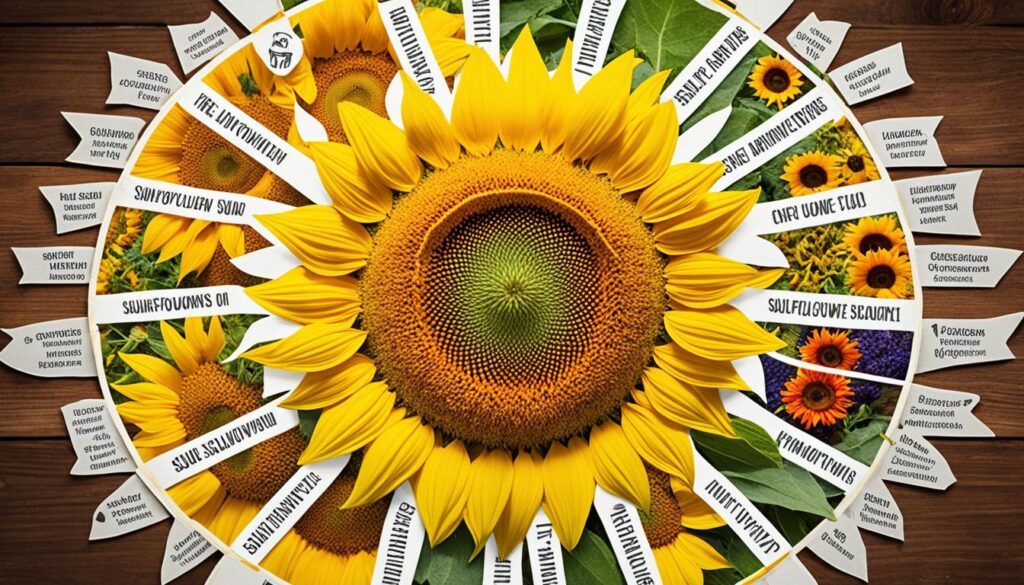
Imagine growing a lovely flower that loves the sun and pulls in many pollinators. That’s what Sunflowers (Helianthus annuus) are all about. They have bright yellow petals and a charming habit of following the sun as it moves. They mean a lot to us, from the Van Gogh picture to the sunflower oil we use. Let’s explore how you can make your sunflower fields and gardens.
About Sunflowers
The sunflower gets its name from Greek. Helios means «sun,» and anthos means «flower.» Sunflowers turn to face the sun, which is called heliotropism. They are plants that live for only one year.
Flower Colors and Characteristics
Sunflowers can be yellow, red, orange, maroon, or brown. The classic sunflower is bright yellow with a brown middle. These flowers can be very big, up to 12 inches across. The plants can get taller than two adults stacked on top of each other.
Heliotropism: Following the Sun
Sunflowers turn their heads to follow the sun from morning to evening. This turning toward the sun is called heliotropism. They do this when they’re still growing and not weighed down by seeds.
Varieties of Sunflowers
There is more than just the classic bright yellow sunflower. A variety of stunning sunflowers are waiting to be discovered. They range from the towering mammoth sunflower to compact options, perfect for small areas. Each kind has unique features that fit various garden needs.
Towering Giants: ‘Mammoth’ Variety
The ‘Mammoth’ sunflower is a traditional giant sunflower. It can grow over 12 feet tall. Its large seeds are great for snacking and bird feeding. If you want a show-stopping garden, this variety is essential.
Eye-Catching ‘Autumn Beauty’
The autumn beauty sunflower stands out with its 6-inch flowers in yellow, bronze, and mahogany. It grows on branching plants up to 7 feet tall. This sunflower makes any garden or flower arrangement beautiful.
Bouquet-Friendly ‘Sunrich Gold’
The ‘Sunrich Gold’ sunflower is perfect for bouquets. It grows to about 5 feet. This variety offers a rich golden-yellow flower with no pollen, ideal for indoor displays without the mess.
Compact ‘Teddy Bear’ for Small Spaces
The ‘Teddy Bear’ sunflower is small, only 2 to 3 feet tall. It’s great for small gardens and pots. Its deep-gold, 5-inch blossoms last for days, adding joy to tiny spaces.
Planting Sunflowers
To get a good sunflower crop, picking the right sunflower planting location is key. Sunflowers need a lot of sunlight, around 6 to 8 hours every day. It’s best to plant them where they’re sheltered from strong gusts. For instance, put them near a fence or a building. This will keep the tall sunflowers from falling over easily.
Soil Preparation
For sunflowers to do well, the soil must drain water well and have lots of organic material. Break up the soil to about 2 feet deep before planting. Add compost or aged manure to the soil. Sunflowers are pretty chill about the type of soil they grow in. They do fine in soil that is a bit acidic or slightly alkaline, with a pH of 6.0 to 7.5.
When to Plant
The best time to plant sunflowers is after spring frost ends and the ground is warm. This is usually from April to mid-June in the north, and in mid-March or early April in the South. You can check the ground temperature. When it hits at least 50°F (10°C), your sunflowers can go in.
Sowing Seeds
Plant sunflower seeds about 1 to 1.5 inches deep in the soil, and space them 6 inches apart. If you plant more than one seed, pull out the weaker plants when they’re 6 inches high. Bigger sunflowers need more space between them. Plant them 30 inches apart. Smaller sunflowers can be closer, about 12 to 18 inches apart.
Growing and Caring for Sunflowers
Sunflowers can handle dry weather, but they love lots of water. Give them water deep in the soil once a week. Use a lot of gallons each time. Be wise with water when it’s very dry or rainy.
These flowers don’t need much food. But, giving them the right flower food helps, especially on poor soil. Remember, too much food near a plant can hurt it. It might get too weak or fall over. Proper caring for sunflower fertilizer and nutrient needs is key.
Providing Support
Big sunflowers may need help standing straight. This is true in windy spots. Use sturdy bamboo sticks or cages for help. This keeps the sunflowers strong and tall. Sunflower staking and supporting tall sunflowers help a lot.
Sunflowers and Pollinators
Sunflowers are loved by bees, butterflies, and birds. Their big, bright flowers are full of nectar and pollen. This makes them perfect for any garden that wants to help the pollinators.
The yellow petals and center of a sunflower pull in many kinds of pollinators. These insects and birds enjoy the sweet nectar and pollen. Sunflowers are especially good for bees. They find a lot of food on sunflowers all year.
Growing sunflowers in your garden helps the local pollinators. It makes a safe space for them. This also helps more plants grow, as pollinators are key for many plants to make seeds or fruit.
You can pick from both tall and short sunflowers. Either way, adding sunflowers to your garden is great for the bees and other pollinators we need. They do a lot to keep our environment healthy.

Harvesting Sunflowers
Sunflowers make any garden pop with color. With the right care, you can enjoy their beauty inside and out. Whether collecting sunflowers for decor or for their seeds, there are crucial steps for a good harvest.
Cutting for Bouquets
To cut sunflowers for bouquets, pick the best moment. Cut them when the bud is almost open. Use sharp scissors to cut the main stem, leaving 6 inches under the flower. This helps the plant grow more flowers on the side.
It’s best to cut sunflowers in the morning. This is when they have the most water. Take off the leaves except the top ones. This helps the flowers last longer. Be careful, as their heavy heads can make the stems weak.
Put the sunflowers in tall vases with fresh water. Change the water every day to keep them fresh.
Harvesting Sunflower Seeds
For harvesting sunflower seeds, you need to be patient. Let the flower heads dry and turn brown. When the petals fall, it’s time to pick them.
Cut the heads off, leaving 6 inches of stem. To get the seeds out, rub the heads or use a washboard. Clean the seeds and let them dry. Store them in a cool, dry place in an airtight container. This way, you can enjoy them throughout the year.
Sunflower Symbolism and Cultural Significance
Sunflowers have a deep meaning across many cultures. They stand for courage, with Native American groups using them for food, medicine, and dye. Sunflowers are the symbol of the «Sunflower State,» Kansas. This shows their strong importance.
Sunflowers are known for their bright, beautiful appearance. They turn to face the sun, marking them as a symbol of loyalty, adoration, and a dream to always aim high. They represent joy and a positive outlook in many societies.
In various cultures, sunflowers are also deeply connected to everyday life. For Native Americans, sunflower seeds are a key food while the flowers are used in medicine and art. Their role in daily activities highlights their cultural importance.
Today, sunflowers still hold a special place in world culture. They’re found in colorful displays, art, and stories, symbolizing happiness, optimism, and the beauty of nature. Sunflowers are cherished for these meanings they bring.
Pests and Diseases
Sunflowers are tough, but birds, squirrels, aphids, slugs, and snails might target them. You can fight these pests with netting, insecticidal soap, or other natural solutions.
Common Pests
Although sunflower pests are not common, birds, squirrels, aphids, slugs, and snails can sometimes be a problem. They eat sunflower parts, which can hurt the plant. Using netting or insecticidal soap is a good way to protect sunflowers from these foes.
Disease Management
Sunflowers don’t get sick often, but they can have issues like fungal infections. If you see signs of sickness (like yellow leaves), act fast. Removing sick plants stops the disease from spreading.
Fun Facts and Trivia
Sunflowers have a fascinating history with many intriguing sunflower facts and sunflower trivia. Here are a few highlights:
- Sunflowers were a staple among Native Americans, used for food, healing, and clothing.
- In 2014, a sunflower in Germany stood at a record-breaking 30 feet and 1 inch.
- They earned Kansas the title, «The Sunflower State.»
- Vincent van Gogh’s masterpiece «Sunflowers» fetched over $39 million in 1987, making it one of the most expensive paintings ever sold.

| Sunflower Fact | Trivia |
|---|---|
| Sunflowers were an important part of the diets and traditions of Native American communities. | The sunflower is the state flower of Kansas, known as the «Sunflower State.» |
| Sunflowers can grow to over 16 feet tall. | An anonymous buyer paid over $39 million for Van Gogh’s «Sunflowers» painting. |
| Sunflowers are heat-tolerant and resistant to pests. | The tallest sunflower ever recorded was grown in Germany in 2014, measuring 30 feet and 1 inch. |
Growing Sunflowers in Containers
Short on garden space? You can still enjoy the beauty of sunflowers. They grow well in containers with the right care. The ‘Teddy Bear’ sunflower is perfect for small gardens. It grows to only 2 to 3 feet tall.
Choose a big enough container when planting sunflowers in pots. It should be at least 12 inches deep and 18 inches wide. Don’t forget drainage holes at the bottom. Use a good potting mix that drains well and has organic matter.
Keep your sunflowers in containers watered often. Potted plants dry out faster than those in the ground. Taller sunflower types might need support as they grow. Staking or using cages can keep them from falling over. With the correct container, soil, and attention, sunflowers will thrive in tight spots.



